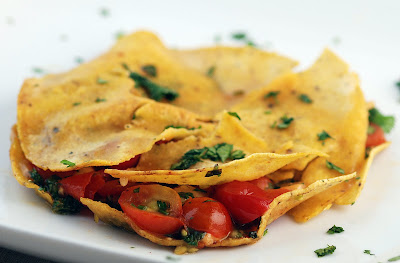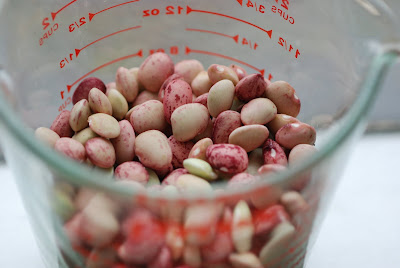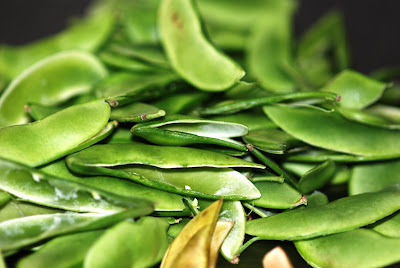Get Growing
Welcome to our seventh Get Growing entry. This series will span 12 months, and is designed to help aspiring vegetable gardeners get out of the kitchen and into the garden. On the first of each month, we will discuss one garden project for the novice vegetable gardener. Because we are located in Houston, Texas, our growing conditions differ from many parts of the English-speaking world. To help guide gardeners in cooler climates, our Get Growing partner is Daphne of Daphne's Dandelions. Daphne gardens in Boston, and she will be providing monthly advice for Northern gardeners (although her excellent site is a wonderful resource for gardeners everywhere). This month, Daphne discusses fall transplants for the Northeast and fighting diseases. Regardless of where you live, her advice is invaluable.
Vegetables that Love the June Heat
May was quite warm, with daily temperatures often hitting the high 90's. There were a few days that offered relief thanks to overcast skies and rain, but now that it's June, we are guaranteed to have four months straight of serious heat. There are many vegetables that we planted earlier in the year that will survive these temperatures, including melons, squash, and snap beans, but not many that should be started this month. Some, including tomatoes, may survive but stop producing flowers and fruit until the temperatures cool off in the fall. Others, especially the last of our fall vegetables, are quickly dying off. There are a few vegetables, though, that love our summer weather. These include eggplant, okra, basil, cowpeas, cucumbers and chile peppers. If you haven't already started these vegetables, June is a good month to do so.
Lima (Butter) Beans
Another great crop to start now is lima beans, also known as butter beans. These plants really love the heat, and seeds for bush beans can be planted as late as July in Zone 9. Because pole lima beans, and in particular Christmas Lima Beans, take such a long time to mature, they really should be planted this month.
If you're from the frozen and canned vegetable generation like we are, you probably think you hate lima beans, particularly that awful succotash combo we were all forced to eat that combined lima beans and corn for an amazingly flavorless, mushy and wholly unappealing dish. Fresh lima beans, though, are a different matter entirely. They are extremely rich and dense, with a distinct flavor that we love.
The fact that they are productive, easy to grow, highly nutritious, and versatile in the kitchen will further endear these beans to you. There is only one drawback to growing lima beans, as opposed to snap beans, from our perspective. This is the work involved in removing the edible beans from the pods. We admit that this is not an enjoyable process, and can only recommend that you sit in front of the tv for distraction during this tedious chore.
Butter Bean Varieties
When deciding whether to grow bush or pole lima beans, there are several factors to consider. The first is how much time you have, both before you want to harvest the beans and before your weather will kill the plants. Bush beans mature more quickly, making them an ideal choice if you want to pick limas in the next few months. They're also a good choice if you're getting a late start, and have only a few months before cool weather starts. Pole beans mature more slowly, but produce for a longer period of time. Our pole beans were still loaded with pods when the first frost hit in late November. They also produce more beans, and the beans tend to be larger.

A second consideration is how much space is available in your garden. Pole beans take up less room because the plants grow vertically, but the vines become quite tall and full. While pole limas are not an option for our front yard where we include only low-growing vegetables, bush limas are well-behaved and look quite attractive in our front border. Remember that the harvest is not the pod itself, but the beans inside. It takes A LOT of pods to get a pound of beans, so it's not worth growing limas if you only have room for a few plants.
A third consideration is taste. Bush limas are smaller than pole limas, with a softer texture and delicate, buttery flavor. These are the beans that earned lima beans the nickname butter beans. Pole beans, though, are also wonderful with a hearty, nutty flavor.
If you can't decide and have enough room in your garden, grow both types of limas. The bush limas will provide an early, delicious harvest while the pole limas will produce pounds of beans over a long period of time. Bush varieties that we recommend are Dixie Speckled Butterpea, Henderson's Bush and White Dixie Butter Baby Lima. Our favorite pole varieties are Christmas and Florida Speckled. This year, we're also trying two lima beans for the first time, Jackson Wonder Butterbean (bush) and White Christmas (pole).

Because butter beans are a member of the legume family, try to plant them in a section of the garden that has not recently contained other legumes to avoid soil-borne diseases. Seeds need warm temperatures in order to germinate, certainly not a problem in Zone 9 in June.
Plant the seeds about an inch deep in a sunny part of the garden in soil with good drainage and lots of organic material. If you have fresh, high-quality seeds, the germination rate will be excellent. This means that almost all of the seeds will produce healthy, vigorous seedlings. To avoid having to thin later, plant the seeds about 5 inches apart for bush beans and about four inches apart for pole beans. If you end up with gaps where the seeds don't germinate, you can go back in and add new seeds to fill in the holes.
For bush beans, we plant the rows quite close together to maximize production in our urban garden. We leave just enough room to walk between rows while harvesting, about a foot and a half. Plant pole beans at the back of the border to avoid blocking the sun from reaching your other plants. If you don't already have poles or stakes in place for the pole beans, it is best to drive these into the soil at the same time that the seeds are started.
Keep the seeds well-watered until they germinate, then be sure to water frequently during hot, dry spells. A thick layer of mulch is a good idea to conserve water and keep the soil evenly moist. The plants will first produce flowers, then beans. Bush beans will be the first to mature, in around two months. Pole beans can take a lot longer, particularly the really big beans such as Christmas. Do not give up hope if months go by without a single flower. Eventually, you will be rewarded with a huge crop of gorgeous lima beans. Of course, then the real work begins when you have to remove them all from their pods.
When to Harvest Butter Beans
Since butter beans are grown for the mature beans inside, it is important not to harvest too early. If you do, inside will be a tiny, immature bean which is not much use in the kitchen. Instead, wait until the pod looks plump and full, and you can see the shape of the rounded bean filling the pod. Feel the pod too. If there are no gaps between the seeds, they are probably ready for harvest. Each pod typically contains two or three butter beans.
After harvesting, bring the beans inside and try to cook them within a day or two. We prefer not to refrigerate our beans because it tends to diminish the flavor dramatically. Just store them in a cool place in the kitchen. Don't remove the beans from the pod until you want to cook with them.
How to Eat Butter Beans
In our opinion, these beans are best eaten when fresh. They can, however, be dried and saved for later use. Many vegetable gardeners just leave the pods on the plants to dry out. But in Houston, our summers are so humid that the beans do not dry well if left outside. In fact, they usually either start sprouting in the pod, or become molded and unusable. If you live in a similar climate, bring them inside after harvesting, remove from the pods, and place them somewhere that gets good air circulation. Try not to pile them on top of one another in a big bowl because they won't dry well. instead, we spread them out on a plate in the kitchen where we enjoy watching the transformation as the beans dry.
Good for You and They Taste Good
Lima beans are an excellent source of dietary fiber, protein, folate, potassium and iron. Just one cup of lima beans contains 14g of protein and over 50% of the daily recommended amount of vitamin C. Limas also provide vitamins B6, K and niacin.
But don't worry that good nutrition means bad flavor. Fresh butter beans are wonderful in pastas, rice dishes, salads and even pureed as a spread or dip. They are familiar to anyone from the South, but are so versatile they can be used in any number of Indian, Italian, African or Asian recipes. The problem for us has never been finding ways to use our harvest, but rather with harvesting enough to make anything at all. Because the beans have to be removed from the pods, remember to harvest about 2 1/2 times the weight of the limas you'll need in the kitchen. And, try to draft your kids, friends, neighbors, and anyone else you can find to help you shuck the beans.
Growing Edamame (Soybeans)
Fall Transplants for the Northeast and Fighting Diseases 














































